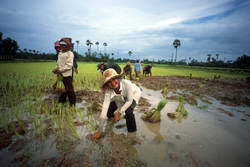Forest and Landscape Restoration Mechanism (FLRM)
The Incentives for Ecosystem Services (IES) project is working with the FAO Forest and Landscape Restoration Mechanism to support the scaling-up of successful restoration practices and initiatives in Cambodia.
FLRM is proposed as an integrated approach that seeks to ensure ecological integrity of restored landscapes and enable sustainable livelihoods. IUCN's Restoration Opportunity Assessment Methodology (ROAM) is being used as a flexible and affordable methodology to identify and analyse FLR opportunities that are ecologically, economically and socially feasible.
The IES approach is closely aligned with the objectives of FAO's FLRM, which seeks to restore the landscape and improve the productivity of landscape actors. IES can support the implementation of FLRM through the development of an enabling environment that can improve the coordination of existing public programmes, private sector investment and civil society initiatives to co-finance packages of multiple incentives to support smallholder farmers int he transition to implement FLRM.
FLR pilot sites
FLR pilot sites
The three target provinces identified include important watersheds which make up a significant part of the upper catchment of the Tonlé Sap Great Lake and include parts of the Kulem Prum Tep Wildlife Sanctuary, Boeng Peae Wildlife Sanctuary, and Prey Lang Wildlife Sanctuary. Given this, there is a great potential for restoration in this landscape to provide connectivity amongst these wildlife sanctuaries and improve the productivity and hydrology of this critical catchment basin for the Tonlé Sap.
Two pilot sites were identified to implement FLR activities: Phnom Kulen National Park and Sihanoukville.
The Phnom Kulen National Park pilot site in Siem Reap province is a popular tourism destination within one of the few remaining tropical forests in northwest Cambodia. It has high environmental - with the Kulen mountain area recognized as a Protected Area in 1993 - and historical value - with UNESCO recommending its inclusion in the Angkor World Heritage Site.
Key threats to the landscape in the Phnom Kulen National Park pilot site include:
- Illegal deforestation of valuable hardwood
- 'Slash and burn' subsistence agriculture for rain-fed rice, cassava, sweet potatoes, etc. encroaching into the forest, and threatening archaeological sites
- Since 2000, conversion of rice production plots to permanent cashew nut tree plantations, forcing clearance of new patches of forest for agriculture
- Privately managed concession to access the mountain
- Unregulated tourism development resulting in litter and pollution, and illegal constructions on ancient sites
- Unexploded ordnance and landmines contaminate many areas
- Insecure land tenure and inequitable distribution of benefits from tourism
Incentives to support FLR in Cambodia

Incentives are needed to support farmers overcome adoption barriers to restore the landscape, improve their agricultural productivity and support the conservation of protected areas through reduce deforestation and forest encroachment.
There is significant scope to include the development of a PES mechanism in the landscape as one incentive option, with downstream water users in Siem Reap compensating upstream farmers on the Kulen mountain for conservation practices to improve water quality and quantity.
Additional incentives to support improved soil fertility, waste management infrastructure development
Capacity building workshop
The IES approach was presented during the Capacity development workshop on National Forest Funds (NFFs), the development of Incentives for Ecosystem Services (IES) and Payments for Ecosystem Services (PES) organized by FAO's FLRM 26-28 April 2017, Siem Reap, Cambodia.
The workshop provided a forum in which to illustrate the spectrum of incentives that could be applied to support FLR activities in the three target provinces: Kampong Thom, Preah Vihear and Siem Reap. It also highlighted with the IES Roadmap how, if better aligned, they could be applied as an innovative financing mechanism and enabling environment to coordinate multiple incentives (including PES and REDD+) co-financed from existing sources for multiple stakeholders in the landscape.
Next steps
Next steps
The IES project will continue to support the FLR team to:
- Develop two pilot sites for FLR in Cambodia: Phnom Kulen National Park and Sihanoukvile
- This includes the development of an incentives plan to support the implementation of the Phnom Kulen National Park management plan
- Develop a CBD Forest Ecosystem Restoration Initiative (FERI) grant proposal to support the development of pilot activities for FLR implementation in Phnom Kulen National Park
This provides an excellent opportunity to demonstrate application of the IES approach on the ground. It will also contribute to an IES case study for Cambodia and policy recommendations and lessons learned for discussion during the IES Asia Regional Policy Dialogue to be held early 2018.
